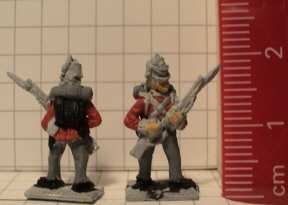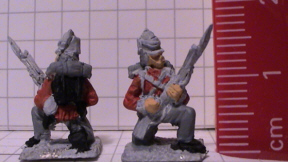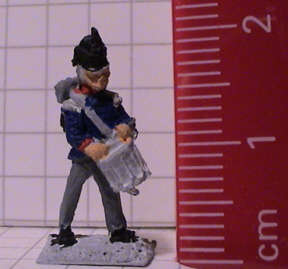 |
|||
 |
|
THIRD SESSION: 60 MINUTES Beginning Status: +9 Minutes I expect to hit my first snag during this session - just a feeling I have. I begin by touching up the tunic fronts. I’m concerned that the first bit of fine detail work will take longer than I expect. Using a nice Vallejo 4/O brush with a very fine tip, I brush in the tunic color between the cross belts, under the arm pits, and at the base of the neck. It occurs to me that I might have saved time by simply painting over all the straps with the larger brush and then touching up the white straps later. But on many of these figures now I may be able to leave the straps just primed. Then, if time permits, add a coat of white. If I’m feeling crunched, I may go this route and leave the straps for a later session (or never). It looks like my schedule estimating is holding up - the tunic detail is complete in 10 minutes. Next comes the flesh. I mix up Vallejo Matt Flesh #955 with a few drops of Slow-Dri. This accomplished two things in one step. First, it thins the thick Vallejo paint to allow it to get into crevices and crannies easily (without covering up any detail). Second, it gives me more time to work with the wet paint. I don’t generally use a wet palate. Since I work in such a small space and on just a dozen figures at a time, I rarely have a need to keep paint wet for very long. I find this technique works very well for me - especially since I use a halogen lamp which generates a lot of heat and, in winter, run a space heater as well (the Chicago winters are all they’re cracked up to be, especially in an English basement!). I go back to my 5/O Floquil brush and lay the flesh on quickly, feeling free to let it run over onto neighboring equipment, etc. It will get covered with the cuff and collar color (Prussian Blue) or the musket stock (dark brown). This takes just a few minutes. Now for the base equipment. For the base equipment I switch back to Model Master flat black, and stick with the Floquil 5/O brush. Now I run down the line doing scabbards, cartridge pouches, and backpacks. The cartridge boxes look more like sacks to me with a large button - I make a note to check my reference material. Perhaps it’s just a sculpting style, or perhaps the British moved away from the rectangular box (my familiarity is more with the Peninsular British). This is fairly quick work with just a little care needed not to let the paint run onto the pants and tunics. Another shortcut missed: when I painted the pants I painted around the scabbards. I should have painted over them then I would not have to spend as much time on the edge between them - a quick stroke or two and I could move on. Still, this moves very quickly. I take this moment to clean up the boots where the scarlet from the jackets had been. I find I’m ahead of schedule so I decide to paint the bedrolls as well. I use the same color as the pants - Model Master Dark Gull Gray #4755 - this also allows me to touch up the pants where scarlet had been spotted on when painting the jackets. As bedrolls are a simple tube, this takes just a few minutes. I make a mental note that when I get to all the white straps, I’ll do the bedroll and backpacks last. Another bit of detail that I will sacrifice if necessary for time. After all, I don’t expect my opponent to see the backs of these figures, and I expect my allies to cut me a break! The third session is now complete and the figures have really taken shape. The drummer worries me - he’ll need at least 10 minutes for some details like the drum. Other than the sashes, the rest of the command figures will only need an extra minute or two a piece. I’m still on track, pleased with the results so far, and I still have my nine minute buffer. THE PICTURES: |
|
|
|
|
[Home] [How To] [Speed Painting] [Speed Painting 2] |
 |



